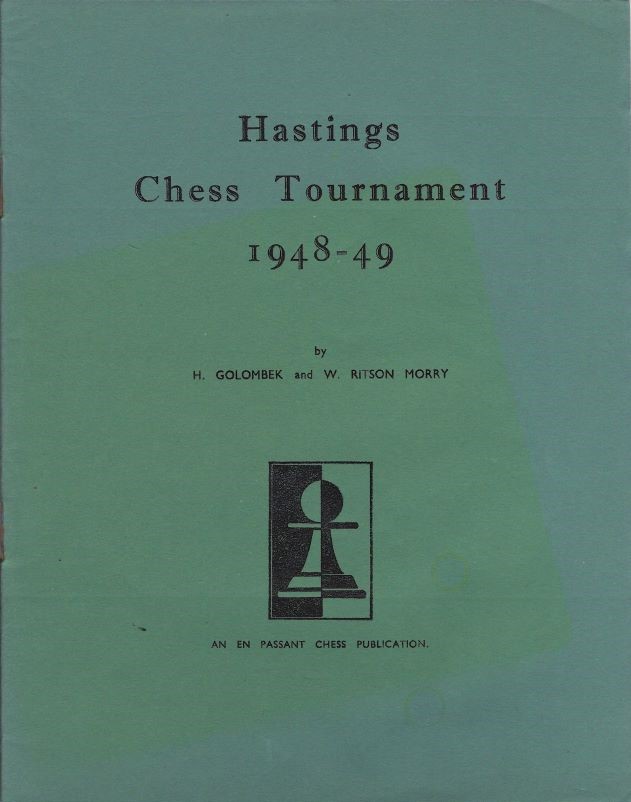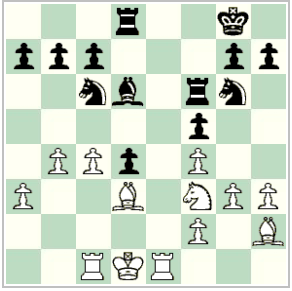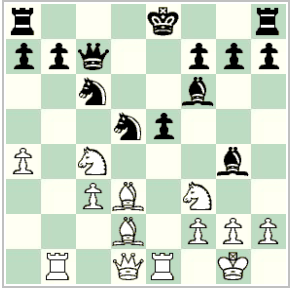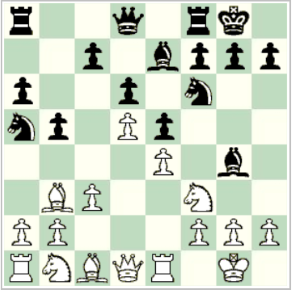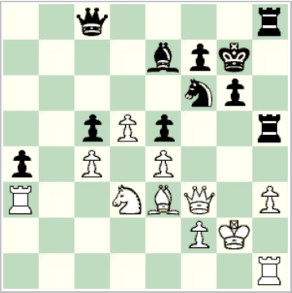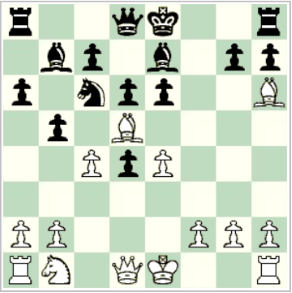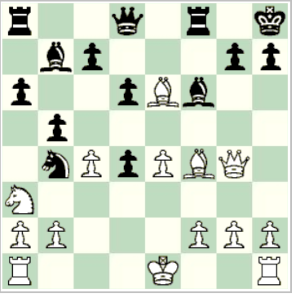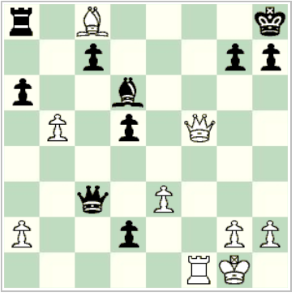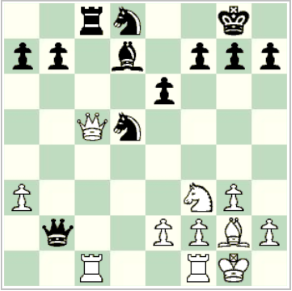The 24th annual international Xmas congress of the Hastings Chess Club was officially opened at 3.45 p.m. on Thursday December 30th, 1948 by Neil Cooper-Key Esq., M.P. for Hastings, supported by the Mayor and other important members of the municipality.
The entry of 131 competitors was a good one, but as was the case last year the Premier section was by no means of the strength which distinguished it in the pre-war period. in 1934, for instance, we saw a triple tie between Sir Geo. Thomas, Flohr and Euwe with Capablanca and Botvinnik below them! In 1937 Reshevsky was the winner with Keres and Alexander in second place and Fine and Flohr just below. Indeed the list of winners: Yates, Kostich, Rubinstein, Euwe, Maroczy, Alekhine, Vidmar, Tartakower, Marshall, Takacs, Colle, Capablanca, Flohr, Thomas, Reshevsky, Szabo and Alexander is in itself an almost complete catalogue of the grandmasters of the last 20 years. These great chessplayers made Hastings and its chess congress world famous. Because of their presence a tradition was built and Hastings was never “just another chess tournament” such as it is now seriously in danger of becoming.
Source: Hastings Chess Tournament 1948-49 by Harry Golombek & W. Ritson Morry (En Passant Chess Publications Ltd.: London (1949), page 1.
Alongside the renowned Premier section, the Congress contained a host of subsidiary sections, and there was a larger than usual Irish contingent competing in these for the 1948-49 renewal.
Five of their games found their way into contemporary reports. Here they are.
The 1948 Irish Champion, Donal O’Sullivan was selected to compete in the second tier Premier Reserves Major. O’Sullivan had to wait until the fourth round before gaining even a draw, in Round 6 he defeated the veteran Jacques Mieses who fled Nazi Germany in 1938 and settled in England. In summer 1949, Mieses was granted the Grandmaster title by FIDE when the world governing body officially set up the system of GM and IM titles.
Donal O’Sullivan – Jacques Mieses
Premier Reserves Major, Hastings 1948-9, Round 6
[Source: Evening Herald, 5th February 1949, page 4]
We join the game after 20 moves of an Albin Counter Gambit – the earlier moves were not given in the newspaper column where the game appeared. Despite the rather unusual position of his dark-squared bishop, not to mention his King in the centre closely flanked by both Rooks, O’Sullivan has the better game. He now commenced manoeuvres into Black’s side of the board and by move 26 had won a pawn.
21.c5 Bf8 22.Ng5 Nce7 23.Bc4+ Nd5 24.Ne6 Rd7 25.Nxc7 Rxc7 26.Bxd5+ Kh8 27.Rc2 Ne7 28.Bb3 h6 29.g4 Rd7 30.g5 Ra6 31.a4 Nd5
A blunder, losing a piece.
32.Re8 Nxb4
If 32…Kg8, then simply 33.Re5.
33.Rxf8+ Kh7 34.Re2 Kg6 35.Re6+ Kh5 36.Rh8 Rxe6 37.Bxe6 Rc7 38.Bxf5 Rxc5 39.Be4 Nd5 40.gxh6 gxh6 41.Bf3+ Kg6 42.f5+ Kxf5 43.Rxh6 Nc3+ 44.Ke1 Rc8 45.Bg4+ Kg5 46.Bf4+ 1-0
[Click to play through the game]
In the final round O’Sullivan faced D.M. Horne, the pre-event favourite, and succumbed to a powerful attack that won the brilliancy prize for this Section.
Dennis Horne – Donal O’Sullivan
Premier Reserves Major, Hastings 1948-49, Round 9
[Sources: Hastings Chess Tournament 1948-49, ibid, pages 31-32 and British Chess Magazine, Vol. LXIX (1949), page 129]
“Black boldly tries to exploit the the change of order in White moves (2.d4, instead of 2.Nf3) to win a pawn; and up to a point does not do too badly. 14…Bf6 is a shocking blunder, however – he must either castle [kingside] or play 14…f6. I must say I should have felt tempted (probably wrongly) to “have a go” and castle [queenside]. The ensuing combination is fairly straightforward, but pretty – at the very end Black is, of course, hopelessly lost, even if he prevents the immediate mate.” – C.H.O’D. Alexander, BCM, ibid.
1.e4 c5 2.d4 cxd4 3.Nf3 Qa5+ 4.Bd2 Qb6 5.Na3 Nc6 6.Bd3 e5 7.Nc4 Qc7 8.a4 Nf6 9.O-O Be7 10.c3 d5 11.exd5 Nxd5 12.Re1 dxc3 13.bxc3 Bg4 14.Rb1 Bf6
15.Rxb7 Qd8 16.Ncxe5 Nxe5 17.Nxe5 Bxd1 18.Ng6+ Ne7 19.Bb5+ Qd7 20.Bxd7+ Kd8 21.Nxh8 Bc2 22.Nxf7# 1-0
[Click to play through the game]
1948/49 Hastings Premier Reserves Major Crosstable
[Source: Hastings Chess Tournament 1948-49, ibid, page 3]
Rank Name R Ba H Sc T Sc Se Bo M O Total 1. H.G. Rhodes X 1 1 ½ ½ 1 1 1 ½ 1 7½ 2. L.W. Barden 0 X 0 1 ½ 1 1 ½ ½ 1 5½ 3=5. D.M. Horne 0 1 X 0 1 0 0 1 1 1 5 3=5. D.B. Scott ½ 0 1 X ½ ½ 1 0 ½ 1 5 3=5. A.R.B. Thomas ½ ½ 0 ½ X 1 0 ½ 1 1 5 6. H.G. Schenk 0 0 1 ½ 0 X ½ 1 ½ 1 4½ 7. E.G. Sergeant 0 0 1 0 1 ½ X 1 0 ½ 4 8=9. P.D. Bolland 0 ½ 0 1 ½ 0 0 X ½ 1 3½ 8=9. J. Mieses ½ ½ 0 ½ 0 ½ 1 ½ X 0 3½ 10. D.J. O'Sullivan 0 0 0 0 0 0 ½ 0 1 X 1½
Horne and Schenk later in 1949 crossed swords again with O’Sullivan in the Premier section of the University College Dublin Congress. Tom Tormey, who we will come to later in this post, also played in that section in Dublin.
The 1947 Irish Champion, Paddy Duignan, was placed in the third tier Premier Reserves Section A and at this slightly lower level was able to put in a strong performance finishing third equal.
Peter Swinnerton-Dyer – Patrick Duignan
Premier Reserves Section A, Hastings 1948-49
[Source: Evening Herald, 5th February 1949, page 4]
The first ten moves were not given in the Herald chess column but the series given here is the most likely course taken to the starting position given in the newspaper, as shown in the diagram below.
1.e4 e5 2.Nf3 Nc6 3.Bb5 a6 4.Ba4 Nf6 5.O-O Be7 6.Re1 b5 7.Bb3 d6 8.c3 O-O 9.d4 Bg4 10.d5 Na5
11.h3 Nxb3 12.axb3 Bh5 13.Nbd2 h6 14.Nf1 Nd7 15.g4 Bg6 16.Ng3 Kh7 17.Kg2 Rh8 18.Be3 Kg8 19.Qe2 h5 20.gxh5 Bxh5 21.Nxh5 Rxh5 22.c4 bxc4 23.bxc4 Qc8 24.Rh1 g6 25.Nd2 Kg7 26.Ra3 Nf6 27.b4 c5 28.bxc5 dxc5 29.Qf3 a5 30.Nb3 a4 31.Nc1 Qa6 32.Rc3 Rah8 33.Nd3 Qc8 34.Ra3
Nxe4 35.Qxe4 Rxh3 36.Rxh3 Qxh3+ 37.Kg1 Rh4 38.Nf4
Hoping for 38…exf4 39.Bd4+ snaffling Black’s Queen.
38…Rg4+ 0-1
[Click to play through the game]
1948/49 Hastings Premier Reserves A Crosstable
[Source: Hastings Chess Tournament 1948-49, ibid, page 3]
Rank Name P C Du We Wa SD I L Sm De Total 1. A. Phillips X 0 ½ 1 ½ 1 1 1 1 1 7 2. H. Courtney 1 X 0 ½ 1 1 1 0 1 1 6½ 3=4. P.A. Duignan ½ 1 X 0 ½ 1 0 ½ 1 1 5½ 3=4. P. Wenman 0 ½ 1 X 0 ½ 1 1 1 ½ 5½ 5. J.C. Waterman ½ 0 ½ 1 X 0 ½ ½ 1 1 5 6. P. Swinnerton-Dyer 0 0 0 ½ 1 X 1 1 0 1 4½ 7. L. Illingworth 0 0 1 0 ½ 0 X ½ 1 ½ 3½ 8. C.H. Llijs 0 1 ½ 0 ½ 0 ½ X 0 ½ 3 9. D. Smith 0 0 0 0 0 1 0 1 X ½ 2½ 10. L. Derby 0 0 0 ½ 0 0 ½ ½ ½ X 2
In the fourth tier Major, in Section A a third Dublin-based player Tom Tormey played alongside the former Belfast player T. Lindsay Moodie. Both defeated the English player Ballard.
A. Ballard – T. Lindsay Moodie
Premier Major A, Hastings 1948-49
[Source: Belfast News-Letter, 19th January 1949, page 6]
T. Lindsay Moodie, formerly of Strandtown Chess Club, scored seven out of a possible nine in the Major A section although ill with bronchitis during most of the tournament … Mr. Moodie won the Irish correspondence Championship in 1925. He left Belfast for London about 25 years ago.” BNL, ibid.”
Black adopted the Steinitz Deferred and White attempted too much with too few pieces. His sacrifice at move ten was barely sound. Had Black played 11…gxh6, a possibility was 12.Qh5+ Kd7 13.Bxe6+ Kxe6 14.Qf5 mate. But after 12…Kf8 White could only draw by perpetual check. Lively play followed White disregarding Pawns in his attack which was correctly met. 27.Bc8 was White’s last effort. It was defeated by 28…Qe1 after which Black came out a piece to the good.” – BNL, ibid.
1.e4 e5 2.Nf3 Nc6 3.Bb5 a6 4.Ba4 d6 5.d4 b5 6.Bb3 exd4 7.Bd5 Bb7 8.Ng5 Nh6 9.c4 Be7 10.Ne6 fxe6 11.Bxh6
11…O-O 12.Qg4 Bf6 13.Bxe6+ Kh8 14.Bf4 Nb4 15.Na3
15…Bxe4
White’s attack has been beaten back and Black has taken over the initiative, but 15…Nd3+ preventing White castling looks stronger; e.g. 16.Kf1 b4 17.Nc2 Nxf4 18.Qxf4 d3 19.Nxb4 Bxb2.
16.O-O d3 17.Rfe1 Bxb2 18.Rab1 Bxa3 19.Rxe4 Qf6 20.Be3 Nc2 21.Rf4 Nxe3 22.fxe3 Qc3 23.Rbf1 Rxf4 24.Qxf4 d5 25.cxb5 Bd6 26.Qf5 d2 27.Bc8
27…Qxe3+ 28.Kh1 Qe1 29.Qb1 Qxb1 30.Rxb1 Rxc8 0-1
[Click to play through the game]
Tom Tormey – A. Ballard
Premier Major A, Hastings 1948-49
[Source: Evening Herald, 5th February 1949, page 4]
1.d4 Nf6 2.Nf3 e6 3.c4 d5 4.g3 c5 5.cxd5 cxd4 6.Qxd4 Nxd5 7.Bg2 Nc6 8.Qd1 Bb4+ 9.Nbd2 O-O 10.O-O Qe7 11.a3 Bxd2 12.Bxd2 Rd8 13.Qc2 Bd7 14.Rac1 Rac8 15.Qc5 Qf6 16.Bg5 Qxb2 17.Bxd8 Nxd8
Better would have been 17…Rxd8 because White now gains a winning material advantage.
18.Qxc8 Bxc8 19.Rxc8
So far it looks as if Black can keep approximate equality by moving his Queen back to protect the d8-Knight, but there is a sting in the tail. He is going to lose a Knight.
19…Qf6
If 19…Qb6 then 20.Rd1 and 21.e4 will follow as in the game continuation.
20.Rd1 Qe7 21.e4 Qd7 22.Ra8 b5
Now this allows White to win more material and checkmate follows shortly afterwards.
23.exd5 exd5 24.Ne5 Qc7 25.Rxd5 Qc1+ 26.Bf1 g6 27.Rdxd8+ Kg7 8.Ng4 h5 29.Rg8+ Kh7 30.Rh8+ Kg7 31.Rag8# 1-0
[Click to play through the game]
1948/49 Hastings Major A Crosstable
[Source: Hastings Chess Tournament 1948-49, ibid, page 4]
Rank Name B Cl M S B Ca T F H Ch Total 1. K.J. Bloodworth X 1 ½ 1 1 1 ½ ½ 1 1 7½ 2=3. N. Clissold 0 X 1 1 0 1 1 1 1 1 7 2=3. T.L. Moodie ½ 0 X 1 1 1 ½ 1 1 1 7 4. P.H. Sullivan 0 0 0 X 1 ½ ½ ½ 1 1 4½ 5=7. A. Ballard 0 1 0 0 X 1 0 0 ½ 1 3½ 5=7. F. Calvert 0 0 0 ½ 0 X 1 1 0 1 3½ 5=7. T. Tormey ½ 0 ½ ½ 1 0 X ½ ½ 0 3½ 8-9. E.J. Fairchild ½ 0 0 ½ 1 0 ½ X ½ 0 3 8=9. H.W. Heneage 0 0 0 0 ½ 1 ½ ½ X ½ 3 10. T.E. Chataway 0 0 0 0 0 0 1 1 ½ X 2½

